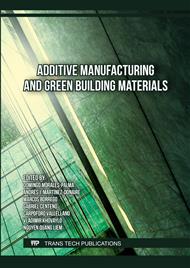p.135
p.143
p.153
p.161
p.171
p.179
p.189
p.195
p.205
Improvement of the Thermal Performance of a Drilling Tool Case by Using Metal Additive Manufacturing
Abstract:
Metal Additive Manufacturing (AM) has been established as one of the most promising solutions when producing new components due to its advantages in creating complex geometries and adding new functionality to the parts. An example of the last, is the usage of conformal cooling in the tooling industry to improve the thermal behaviour of components in-service. The application of this solution is even more meaningful when using metallic materials with high thermal conductivities (e.g. Aluminium alloys). These are mainly selected when the final weight is a key factor in the final component performance, compared with other conductive materials like copper alloys. This study presents the improvement of the thermal behaviour of a drilling tool case manufactured in Aluminium. The selected application case lacks the possibility of evacuating the heat produced by an engine. A redesign of the component is presented, considering the advantages of Powder Bed Fusion – Laser/Metal (PBF-L/M). Both passive and active heat dissipation are analysed by including the reticular structure and internal cavities with forced air. The study is performed first at coupon level and later in the redesigned case manufactured by PBF-L/M. Infrared Thermography (IRT) inspections are conducted to investigate the thermal dissipation when heating the components, and also to monitor the cooling down process. A comparative thermal analysis between the initial case manufactured by the conventional process and the redesigned AM case is also presented.
Info:
Periodical:
Pages:
171-177
Citation:
Online since:
September 2023
Authors:
Keywords:
Price:
Сopyright:
© 2023 Trans Tech Publications Ltd. All Rights Reserved
Share:
Citation:



